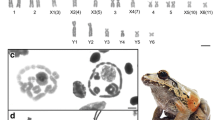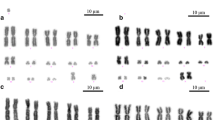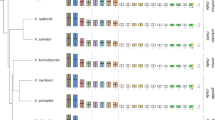Abstract
The occurrence and form of sex chromosomes were investigated with the aid of C-banding and 4′-6-diamidino-2-phenylindole (DAPI) staining in 13 species of lacertid lizards. The results obtained show the presence in five species of a female heterogamety in which the two sex chromosomes have the same shape and size, but the W differs from the Z in being almost entirely heterochromatic. This condition is clearly similar to that found in some snakes and considered to be an early stage of differentiation of sex chromosomes by Singh et al. (1976, 1980). A more evolved condition may be that found in three other species in which the W is distinctly smaller than the Z. A third situation is that found in all Podarcis species which, even though they are considered to be among the more evolved species in the family, possess two sex chromosomes that are indistinguishable. In general, the situation in lacertids may be compatible with the hypothesis of sex chromosome evolution put forward by Singh et al. (1976, 1980). However a differentiation mechanism of this kind does not seem to be well established in lacertids, and is probably not the only mechanism that is in operation in this family.
Similar content being viewed by others
References
Arnold EN (1973) Relationships of the palearctic lizards assigned to the genera Lacerta, Algyroides and Psammodromus (Reptilia: Lacertidae). Bull Br Mus (Nat Hist) (Zool) 25:291–366
Arnold EN (1984) Variation in the cloacal and hemipenial muscles of lizards and its bearing on their relationships. In: Ferguson MWJ (ed) The structure, development and evolution of reptiles. Symp Zool Soc Lond No 52, Academic Press, London, Orlando, pp 47–85
Bhatnagar AU, Yoniss YTh (1976) A proof of female heterogamety in a lacertid lizard Ophisops elegans. Cytologia 41:507–511
Chevalier M (1969) Données nouvelles sur le caryotype du lezard vivipare (Reptile, Lacertilien). Existe-t-il une hétérogametie femelle de type Z1Z2W. C R Seances Acad Sci Paris 268:2098–2100
Chevalier M, Dufaure JP, Lecher P (1979) Cytogenetic study of several species of Lacerta (Lacertidae, Reptilia) with particular reference to sex chromosomes. Genetica 50:11–18
Darevsky IS, Kupriyanova LA, Bakradze MA (1978) Occasional males and intersexes in parthenogenetic species of Caucasian rock lizards (genus Lacerta). Copeia 1978:201–207
De Smet WHO (1981) Description of orcein stained karyotypes of 36 lizard species (Lacertilia, Reptilia) belonging to the families Teiidae, Scincidae, Lacertidae, Cordylidae and Varanidae (Autarchoglossa). Acta Zool Pathol Antverp 76:73–118
Gorman GC (1969) New chromosome data for 12 species of lacertid lizards. J Herpetol 3:49–54
Ivanov VG, Fedorova TA (1970) Sex heteromorphism of chromosomes in Lacerta strigata Eichwald. Tsitologiya 12:1582–1585
Ivanov VG, Fedorova TA (1973) Heterochromosomes in the karyotype of Eremias arguta Pall. Tsitologiya 15:762–765
Ivanov VG, Bogdanov OP, Anisimova EYu, Fedorova TA (1973) Studies of the karyotypes of three lizard species (Sauria, Scincidae, Lacertidae). Tsitologiya 15:1291–1296
Lopez-Jurado LF, Cano J, Baez M (1986) Estudios sobre la herpetofauna Canaria I. El cariotipo de Gallotia simonyi stehlini y de G. atlantica spp. en poblaciones de la isla de Gran Canaria. Amphibia-Reptilia 7:259–270
Mengden GA (1981) Linear differentiation of the C-band pattern of the W chromosome in snakes and birds. Chromosoma 83:275–287
Moritz C (1984a) The origin and evolution of parthenogenesis in Heteronotia binoei (Gekkonidae) I. Chromosome banding studies. Chromosoma 89:151–162
Moritz C (1984b) The evolution of a highly variable sex chromosome in Gehyra purpurascens (Gekkonidae). Chromosoma 90:111–119
Odierna G, Olmo E, Cobror O (1985) C-band variability in some Lacertidae (Sauria, Reptilia). Experientia 41:944–946
Olmo E (1986) A. Reptilia. In: John B (ed) Animal cytogenetics 4 Chordata 3. Gebrüder Borntraeger, Berlin-Stuttgart
Olmo E, Cobror O, Morescalchi A, Odierna G (1984) Homomorphic sex chromosomes in the lacertid lizard Takydromus sexlineatus. Heredity 53:457–459
Olmo E, Odierna G, Cobror O (1986) C-band variability and phylogeny of Lacertidae. Genetica 71:63–74
Schweizer D (1980) Simultaneous fluorescent staining of R bands and specific heterochromatin regions (DA-DAPI bands) in human chromosomes. Cytogenet Cell Genet 27:190–193
Singh L, Purdom IF, Jones KW (1976) Satellite DNA and evolution of sex chromosomes. Chromosoma 59:43–62
Singh L, Purdom IF, Jones KW (1980) Sex chromosomes associated satellite DNA: evolution and conservation. Chromosoma 79:137–157
Singh L, Phillips C, Jones KW (1984) The conserved nucleotide sequences of Bkm, which define Sxr in the mouse are trancribed. Cell 36:111–120
Sumner AT (1972) A simple technique for demonstrating centromeric heterochromatin. Exp Cell Res 75:304–306
Author information
Authors and Affiliations
Rights and permissions
About this article
Cite this article
Olmo, E., Odierna, G. & Capriglione, T. Evolution of sex-chromosomes in lacertid lizards. Chromosoma 96, 33–38 (1987). https://doi.org/10.1007/BF00285880
Received:
Revised:
Issue Date:
DOI: https://doi.org/10.1007/BF00285880




